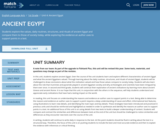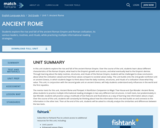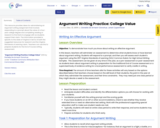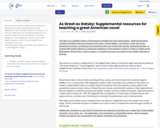
English Instructional Plan – Analyzing Media Messages for Action Research
- Subject:
- Communication and Multimodal Literacy
- English
- Material Type:
- Lesson Plan
- Author:
- VDOE Project Team
- Date Added:
- 04/12/2022

English Instructional Plan – Analyzing Media Messages for Action Research

English Instructional Plan – Analyzing Media Messages Grades 4-5

English Instructional Plan – Analyzing Sarcasm and Ambiguity in Media and Text

English Instructional Plan – Analyzing Word Choice in Paired Texts

English Instructional Plan – Analyzing Word Choice in Paired Texts

English Instructional Plan – Analyzing Word Choice in Paired Texts

English Instructional Plan-Analyzing and Planning Persuasive Writing 7-8

English Instructional Plan – Analyze the Rhetoric of Persuasive Speech

In this unit, students explore ancient Egypt. Over the course of the unit students learn and explore different characteristics of ancient Egypt and what the ancient Egyptians valued. Through learning about the daily routines, structures, and rituals of ancient Egypt, students will be challenged to draw conclusions about what the civilization valued and how those values compare to society today. Students will also learn about the role that mummies and pyramids played in ancient Egyptian society and why archeologists and scientists have been intrigued by them ever since. In second and third grade, students will continue their exploration of ancient civilizations by learning more about ancient Greece and ancient Rome. It is our hope that this unit, in conjunction with the others in the sequence, will help students understand and appreciate early civilizations that have had a lasting impact on the world.
In reading, this unit focuses on understanding the reasons and evidence an author uses to support points in a text. Being able to determine the reasons and evidence an author uses to support a point requires a deep understanding of cause and effect, informational text features, using illustrations to learn new details, and identifying the main topic and key details. These strategies have been introduced and practiced in previous units and should be reinforced and highlighted as needed in order to synthesize and identify the reasons an author uses to support points in a text. An additional focus of this unit is on using details from two texts to build a deeper understanding of content. Students will compare and contrast the similarities and differences between texts at the end of the unit but should be challenged to notice similarities and differences as they encounter new texts over the course of the unit.
In writing, students will continue to write daily in response to the text. At this point students should be fluid in writing about the text in a structured way. Therefore, the focus of this unit is on pushing students to include the best and most accurate evidence and then to explain the evidence with inferences or critical thinking.

In this unit students explore the rise and fall of the ancient Roman Empire. Over the course of the unit, students learn about different characteristics of the Roman Empire, what lead to the Empire's growth and success, and what eventually lead to the Empire's demise. Through learning about the daily routines, structures, and rituals of the Roman Empire, students will be challenged to draw conclusions about what the civilization valued and how those values compare to societal values today. This unit builds onto the 2nd grade nonfiction unit on ancient Greece, in which students began to think about how the daily routines, structures, and rituals of a civilization show what they value. This unit, in conjunction with the second grade unit on ancient Greece, will help students understand early influences in the world and the first republics.
The mentor texts for this unit, Ancient Rome and Pompeii: A Nonfiction Companion to Magic Tree House and Eye Wonder: Ancient Rome, allow students to practice multiple informational reading strategies in two very different text structures. In both texts, but predominately in Eye Wonder, students will practice using a multitude of text features and illustrations as a way of learning new information about a topic. Over the course of this unit, students will constantly be thinking about how the information from one text builds on and connects to the information in the other text. Then at the end of the unit, students will be asked to critically analyze the similarities and differences between the two texts.

In this science-based unit, students begin their exploration of animals and animal adaptations. Using next generation science standards as a guide, students explore three main topics: how different animals use their body parts and senses in different ways in order to survive, the ways in which the behavior of different animal parents and offspring help the offspring survive, and the similarities and differences among individual animals of the same kind. This unit is part of a larger progression on understanding animals and the animal kingdom. In kindergarten, students learn about how animals meet their basic needs for survival and how that varies depending on the season. In second grade, students learn about different habitats and how animals in the habitat rely on the environment for survival. Then in third grade, students study animal adaptations and the different ways animals adapt in order to survive, especially when threatened by environmental changes. It is our hope that this unit, in combination with others in the sequence, will help students develop a deeper understanding of the animal kingdom and life science.
This unit includes a mix of read-aloud texts and shared-reading texts. Students will focus on different skills depending on the method in which the text is consumed. During read aloud, students will refine their skills in describing the connection between ideas and pieces of information, figuring out the meaning of unknown words, distinguishing between information provided by the pictures and information in the text, and identifying the reasons an author gives to support points in a text. During shared reading, students will predominately focus on identifying the main topic of a section of a text, retelling key details that match the main topic, and using text features to locate key facts and information. Because the shared reading days are meant to be student driven, not teacher driven, the target tasks are at a more accessible, independent level for students. There are also not a lot of key questions already planned for shared reading days. Questions should be written and spiraled in based on student needs and student reading levels.
In writing, this unit builds on the work students did in unit one. Students will continue to write daily in response to the text, with a focus on correctly answering questions and adding an inference or critical thinking.

Writing and algorithms are a set of words (program in CS terms) that are meant to “accomplish a task as a means of creative expression or scientific exploration.” In this lesson, the student will utilize a block based programming platform (scratch) to animate a story that they have created in previous lessons. While this is a unit with steps to this point, you can also use this as a stand alone. The first 2 lessons are character building and plot building. The third is also a character builder, but is more abstract.

Analyze and describe the role of imagery in poems linked by theme.

This guided reading of Edgar Allan Poe’s “Annabel Lee” (1849) focuses on developing student understanding of imagery and other figurative language, strengthening reading comprehension, and strengthening expository and persuasive writing skills.

Students will use their five senses to describe the three different types of apples using the words from the word bank. Afterwards students will conduct a short survey to find out which apple was liked by most students. The results will be shown by drawing a pictograph.

English Instructional Plan – Applying Knowledge of Media Messages Grades 4-5

This resource provides ideas for administering an argument writing assignment that involves responding to a prompt about the value of a four-year college degree and completing reading or research to find facts to engage with as students support their claim. The information provided is specific to the state of Virginia in terms of both the suggested resources for research and the Virginia Standards of Learning rubric. Teachers can use this to prepare students for the End of Course writing assessment.

English Instructional Plan – Argumentation Editorial Concerning a Current Social/Health Issue

Students will research Artificial Intelligence to give examples and explain how computer science has changed the world and express how computing technologies influence, and are influenced by cultural practices.

This resource is a list of supplemental materials for teachers to consider when teaching F. Scott Fitzgerald's novel The Great Gatsby. This resource is a remix (or addendum) to The Digital Public Library of America's open educational resource "The Great Gatsby by F. Scott Fitzgerald." Here is a link to that original resource, which is full of supplemental materials to the novel: https://goopenva.org/courses/the-great-gatsby-by-f-scott-fitzgerald-2/view.